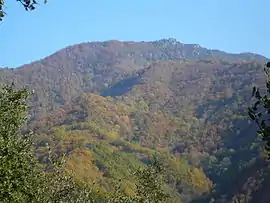Guilleries
The Guilleries Massif (Catalan Les Guilleries) is a mountain system located at the apex of the Catalan Transversal Range and the Pre-Coastal Range. The highest point of the range is Sant Miquel de Solterra or Sant Miquel de les Formigues (1.204 m), other main peaks are Turó del Faig Verd (1,187 m), Rocallarga (1,187 m), Sant Benet (1,149 m), El Far (1,111 m), Sant Gregori (1 ,094 m), Montdois (930 m), L'Agullola (921 m) and Turó del Castell (851 m)[1]
| Guilleries | |
|---|---|
 | |
| Highest point | |
| Elevation | 1,202 m (3,944 ft) |
| Coordinates | 41°56′34.93″N 2°24′49.39″E |
| Geography | |
| Location | Selva, Catalonia |
| Parent range | Catalan Pre-Coastal Range and Catalan Transversal Range |
| Geology | |
| Mountain type | Metamorphic rock |
| Climbing | |
| Easiest route | From Sant Hilari Sacalm or from Osor |

The Guilleries is one of the few places in the Catalan Mediterranean System where amphibolite facies conditions are found.[2] The Pantà de Susqueda and Pantà de Sau reservoirs, of great importance for Barcelona metropolitan water supply, are located in the Guilleries area.
These mountains were notorious in former times for being a haunt of bandits and highwaymen.[3]
The main towns in the Guilleries area are Sant Hilari Sacalm, Osor, Susqueda, Vilanova de Sau, Sant Sadurní d'Osormort, Espinelves and Viladrau.
See also
- Catalan Pre-Coastal Range
- Catalan Transversal Range
- Espai Natural de les Guilleries-Savassona
References
- "Mapa Topogràfic de Catalunya". Institut Cartogràfic de Catalunya. Retrieved September 9, 2010.
- Hercynian Metamorphism in the Catalonian Coastal Ranges
- Revista Els Cingles n 17. - Serrallonga, Bandoler de les Guilleries